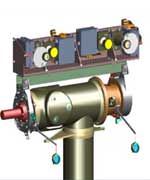
Image credit: NASA/JPL
NASA has suspended use of one of the mineral-identifying tools on the Opportunity Mars rover while experts troubleshoot a problem with getting data from the instrument, the robot’s miniature thermal emission spectrometer.
“As always, our first priority is to protect the instrument, so we have turned it off while we plan diagnostic tests,” said Jim Erickson of NASA’s Jet Propulsion Laboratory, Pasadena, Calif., project manager for the Mars Exploration Rover Project. “Opportunity’s other instruments are healthy and providing excellent science, and Spirit’s entire instrument suite is working well and being kept busy by the science team.”
Both Opportunity and Spirit, its twin, have been examining Mars since January 2004, more than four times as long as their successful three-month primary missions. While researchers work to diagnose the spectrometer-data problem and seek the best way to mend it or work around it, Opportunity is continuing its journey and observing a crater called “Vostok.” On the other side of the planet, meanwhile, martian winds have revealed themselves as dust devils in new images from Spirit and caused mixed effects on the rover itself, depositing dust on a camera and removing dust from solar panels.
On March 3 and 4, Opportunity transmitted data sets for 17 successful readings by its miniature thermal emission spectrometer but also reported that eight other attempted readings yielded incomplete data sets. This spectrometer, from high on the rover’s mast, observes rocks and other targets from afar. It measures the infrared radiation they emit in 167 different wavelengths, providing information about the targets’ composition. Two other types of spectrometers, mounted on the rover’s robotic arm, provide additional information about composition when the rover is close enough to touch the target.
Researchers are considering several possible root causes for the spectrometer-data problem. One possibility is malfunctioning of an optical switch that tells a mirror in the instrument when to begin moving. Another is that the mirror is not properly moving at a constant velocity. “If it is the optical switch, we could use a redundant one built into the instrument,” said Dr. Phil Christensen of Arizona State University, Tempe, lead scientist for the miniature thermal emission spectrometers on both rovers. He added that, if the root cause cannot be remedied, scientists could still get useful data from the instrument in its currently impaired condition.
Even a total loss of the miniature thermal emission spectrometer would not end the rover’s usefulness. In fact, NASA took a calculated risk by disabling this instrument on Opportunity 10 months ago, though the current problem appears unrelated to potential damage anticipated then. At that time, rover operators began using a “deep sleep” technique to conserve energy on Opportunity during reduced-sunshine months of Mars’ winter. Turning off power to overnight heaters let the instrument get cold enough to possibly damage its beam-splitter. However, the spectrometer kept working through the coldest months. Christensen said, “What we’re seeing now does not appear to be any problem with the beam-splitter.”
The rover team is not restricting use of Spirit’s miniature thermal emission spectrometer while troubleshooting the problem on Opportunity.
Spirit’s work capabilities grew with a sudden jump in output from solar panels on March 9, which caused the daily power supply to double. In a possibly related development three days earlier, some dust appeared to have blown onto lenses of Spirit’s front hazard-avoidance camera, enough for slight mottling in images from both the left and right eyes of the stereo camera, but not enough to affect the usefulness of the camera. Mottling in left-eye images cleared markedly the same day the power increased. Team members speculated that Spirit’s power boost, like similar ones on Opportunity in October, resulted from wind removing some accumulated dust from solar panels. Spirit captured pictures of dust-lofting whirlwinds on March 10, adding evidence for windy local conditions. Images the next day showed solar panels cleaned of most of their dust buildup.
Opportunity’s rear hazard-avoidance camera picked up some dust contamination three months ago. The dust on it has not affected operations and has neither decreased nor increased perceptibly since first noticed. No dust has contaminated lenses of the navigation cameras or panoramic cameras on either rover. From all cameras combined, the rovers have returned more than 72,000 images. Images and other geological data from Spirit and Opportunity are successfully providing unprecedented evidence about wet environmental conditions in Mars’ past.
JPL, a division of the California Institute of Technology in Pasadena, has managed NASA’s Mars Exploration Rover project since it began in 2000. Images and additional information about the rovers and their discoveries are available on the Internet at http://www.nasa.gov/vision/universe/solarsystem/mer_main.html and http://marsrovers.jpl.nasa.gov.
Original Source: NASA/JPL News Release
